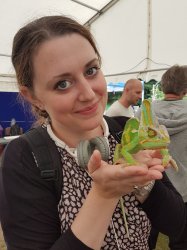

Here’s a batch of fresh news and announcements from across Imperial.
From research into how ions behave in fusion reactions, to a study on why some people develop scar tissue in their lungs following severe COVID-19 infection, here is some quick-read news from across the College.
Fusion surprises
 Ions may behave differently in fusion reactions than previously expected, providing important insights for the future design of a laser–fusion energy source.
Ions may behave differently in fusion reactions than previously expected, providing important insights for the future design of a laser–fusion energy source.
During laser-fusion experiments, lasers heat a fuel consisting of deuterium and tritium ions – heavier variants of hydrogen – to create plasma in which fusion reactions occur. The energy produced by the reactions heats the fuel resulting in higher temperatures and in turn creates more reactions, resulting in a runaway process (thermonuclear burn).
To further explore these reactions, researchers at Lawrence Livermore National Laboratory measured the temperature of deuterium and tritium ions in a burning plasma by analysing the distribution of neutrons that are created during fusion reactions. They observed more ions with higher energies compared to previous experiments with non-burning plasmas.
Imperial researchers then developed a theory to interpret the result, suggesting that it indicates that plasma behaves differently when a thermonuclear burn starts, questioning some standard assumptions about laser-fusion energy experiments.
Read the full paper in Nature Physics.
Unravelling complexity science
 Professor Henrik Jeldtoft Jensen, from Imperial’s Department of Mathematics, has launched ‘Complexity Science: The Study of Emergence’, published by Cambridge University Press.
Professor Henrik Jeldtoft Jensen, from Imperial’s Department of Mathematics, has launched ‘Complexity Science: The Study of Emergence’, published by Cambridge University Press.
Ecosystems, the human brain, ant colonies, and economic networks are all complex systems displaying collective behaviour, or emergence, beyond the sum of their parts. Complexity science is the systematic investigation of these emergent phenomena, and stretches across disciplines, from physics and mathematics to biological and social sciences.
The book provides detailed coverage of this rapidly growing field, accommodating readers from a variety of backgrounds, and equipping them with the key mathematical tools central to complexity science.
The book is described as a ‘masterpiece’ by one reviewer, and a ‘well-thought-through textbook that presents complexity science as a whole, rather than as a collection of single topics.’
Find out more and buy the book on Cambridge University Press or Amazon.
Artificial cells mimic circadian rhythms
 Imperial scientists have created artificial cells that mimic biological cells’ circadian rhythms by responding to light signals.
Imperial scientists have created artificial cells that mimic biological cells’ circadian rhythms by responding to light signals.
These artificial cells are tiny ‘nanoreactors’ that are engineered to emulate real life cells. The researchers, from the Departments of Materials and Bioengineering, engineered these cells so they reacted to light stimuli in cyclic oscillations that emulate the circadian rhythms found in nature.
Lead author Dr Omar Rifaie Graham of the Department of Materials said: “Circadian rhythms exist in all terrestrial creatures. They are the biological changes that follow 24-hour light/dark cycles affecting sleep, appetite, and even plant metabolism.
“We demonstrated that we can manipulate artificial cells using light, meaning we have given them a kind of circadian rhythm of their own.”
The researchers say their findings could have implications for the eventual use of artificial engineered cells in applications like the external manipulation of bacteria and yeast to produce pharmaceuticals, vaccines, and fuel from biowaste products without gene editing.
Read the full study in Nature Chemistry.
COVID scars
 Imperial experts may have uncovered why some people develop scar tissue in their lungs following severe COVID-19 infection.
Imperial experts may have uncovered why some people develop scar tissue in their lungs following severe COVID-19 infection.
The researchers looked at 46 people with severe COVID-19 who needed hospital care and compared them to 18 people with mild COVID-19, as well as 17 healthy individuals who had not caught the virus.
They found that people who had lung scarring post-recovery had unusually high numbers of white blood cells called neutrophils in their lungs, which may explain why they have persistent symptoms from the infection. The team believes understanding this mechanism could point towards possible new treatment approaches for patients with severe disease who develop longer term complications.
Study author Dr Aran Singanayagam, from Imperial’s Department of Infectious Disease, said: “A proportion of individuals develop lung scarring after a bout of severe COVID-19, but the reasons why have been unknown.
“Our study reveals that this complication may be induced by excessive numbers of white blood cells called neutrophils which are drawn into the lungs during COVID-19 and can induce lung damage and subsequent scarring. This scarring can lead to persistent symptoms after recovery.”
Read the full study in Science Translational Medicine.
Main image credit: Shutterstock. Want to be kept up to date on news at Imperial? Sign up for our free quick-read daily e-newsletter, Imperial Today.
Want to be kept up to date on news at Imperial? Sign up for our free quick-read daily e-newsletter, Imperial Today.
Article text (excluding photos or graphics) © Imperial College London.
Photos and graphics subject to third party copyright used with permission or © Imperial College London.
Reporters

Conrad Duncan
Communications Division
Hayley Dunning
Communications Division

Contact details
Email: press.office@imperial.ac.uk
Show all stories by this author

Caroline Brogan
Communications Division

Contact details
Email: press.office@imperial.ac.uk
Show all stories by this author




Leave a comment
Your comment may be published, displaying your name as you provide it, unless you request otherwise. Your contact details will never be published.